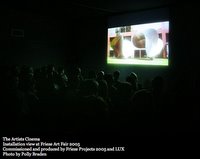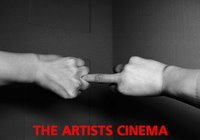

 Schadenfreude
Schadenfreude
Curated by
Tirdad Zolghadr A Touring Project of The Artists Cinema
Schadenfreude
A new touring programme of international artists' work exploring questions of voyeurism and conflict.
TOURING VENUES AND DATES
7 February, FACT, Liverpool, UK
www.fact.co.uk 11 April, Centre for Contemporary Arts, Glasgow
www.cca-glasgow.com 9 March, Arnolfini, Bristol, UK
www.arnolfini.org.uk 4-9 may, Oberhausen Short Film Festival, Germany
www.kurzfilmtage.de Programme details
'These days, projects reflecting on the present context of military violence constitute a dilemma very typical of political activism as a whole. It seems one has to choose between sentimentalized / didactic / (counter) propagandistic takes on the issue OR the even more depressing option of retreating to insular, strictly local navel-gazing. To de-spectacularise can hardly be a viable alternative either. The challenge here, I find, is not that of summoning selfless goodwill or progressive content, but that of finding intelligent forms of voyeurism, i.e. a mode of visual production that faces up to the inevitable, to its own strategies of entertainment or objectification, without any apologetic backflips or self-reflexive mise-en-abîme - strategies that are hard-hitting without being retrograde, and that elude simple notions of solidarity and empathy in favor of an analysis of the very fascination for the outlandish, be it touching or violent or both.
In terms of structure, the works in this programme, without ever succumbing to storytelling narrative, all aim for certain patterns of suspense or anticipation, with most of them resorting to difference in repetition, at times subtle, at times slightly overbearing. All are rather understated in their visual ingredients, making their point on the frisson of flinching in wry, succinct ways, rather than elaborate filmic sophistication.
In the concluding chapter of Regarding the Pain of Others, Susan Sontag asks “Is there an antidote to the perennial seductiveness of war? And is this a question a woman is more likely to pose than a man? (Probably yes.)” Having drawn out a list of works that deals with these and other priorities, I realised with unpleasant surprise that the selection amounted to an all-male list. After an initial bout of panic, flicking through my mental inventory of woman artists, I tried to fathom why exactly it turned out this way in the first place. I still haven't found an answer. But I concluded that for a programme addressing the politics of voyeurism, it might raise more interesting questions to label an ostensibly “male” gaze as such, rather than indulge in tactics of de-essentialization which ultimately cannot escape the tokenisms they're out to debunk.
Perhaps this dilemma mirrors the one sketched out above: is approaching an ethically hairy issue, and (semi-critically) repeating old mistakes with declared skepticism, the lesser evil? Or is it a better idea to transgress, using any means necessary, any traditional territories, coûte que coûte, no matter how crude or blunt ones conceptual and rhetorical instruments may be?
A lose-lose situation, perhaps, but the above junction of different issues may open a tiny patch of new ground for the usual, shopworn questions of voyeurism, representation and visual politics.'
Tirdad Zolghadr
AHMET ÖGÜTCUT IT OUT (Turkey, 2004, 2mins)
Ögüt's Cut it Out is a sardonic take on what is perhaps the newest TV genre that can safely lay claim to any political impact, one that has already established its own codes and conventions as a genre – the self-staged statement on the part of armed insurgents. Ögüt's film employs these codes in a manner that is striking and humorous, though it remains open on whom the joke is – the genre, the audience, or the artwork itself. Courtesy of the artist.
Born in Diyarbakir, Turkey in 1981. Graduated from Hacettepe University, Fine Art Faculty, Painting Department. He currently works as a researcher at the Yildiz Teknik University and lives in Istanbul. He has exhibited widely, including 9th International Istanbul Biennial, Platform Garanti Contemporary Art Center, Instanbul, Ikon Gallery, Birmingham, and The Museum of Modern Art Slovenia.
CHRISTOPH BÜCHEL
AC 130 GUNSHIP (Switzerland, 2004, 9mins)
Büchel's AC 130 Gunship, in some ways a cornerstone of the programme, is an edited documentation of a US attack on a building complex somewhere in rural Afghanistan. The violent nonchalance of the off-voices of military pilots becomes all the more chilling as one realises that the brutality unfolding on the screen is irresistibly entertaining. Courtesy of the artist and Hauser & Wirth Zürich.
Born 1966 in Basel, Switzerland, lives and works in Basel. Recent exhibitions have included Always a little further, Arsenale, 51st International Art Exhibition, La Biennale di Venezia, Italy; Sharjah International Biennial 7, Sharjah, United Arab Emirates; Dionysiac, Centre Pompidou, Paris; Close Quarters, Kunstverein Freiburg; Untitled, Swiss Institute New York; Guantanamo Initiative, Centre Culturel Suisse (with G.Motti), Paris; Under Destruction, MNAC, Palace of the People (with G.Motti), Bucharest; 1st international Biennial of Contemporary Art of Sevilla , Spain; The beauty of failure and the failure of beauty, Mirò Foundation Barcelona.
AKRAM ZAATARI
SAIDA. JUNE 6, 1982 [extract] (Lebanon, 2004, 4mins)
Zaatari's, Saida. June 6, 1982, is perhaps his one most elegant rendition among the many visual inquiries into the value of documentation and the possibility of historical memory, a piece that renders the bomb explosions of that day as beautiful as they were terrifying, by way of an ingenious juxtaposition of only six photographs Zaatari took of the attack. Courtesy of the artist and Sfeir Semler Gallery
Akram Zaatari is a video artist and curator who lives and works in Beirut. In addition to his television and teaching experiences, he is the author of more than 30 videos and video installations exploring political issues pertinent to the Lebanese post-war condition, particularly the logic of religious and national resistance and the mediation of political conflicts through television such as in All Is Well on the Border (1997). Co-founder of the Arab Image Foundation (Beirut), Zaatari based his work on collecting, studying and archiving the photographic history of the Middle East.
MIGUEL CALDERON
INVERTED STAR (Mexico, 2002, 4mins)
Calderon's Inverted Star departs from war issues, turning to a more general inquiry into questions of sensationalism and testimony. For this piece, Calderon posted announcements in newspapers offering a small sum to anyone possessed by the devil who would be willing to be filmed. It is a brilliant take on poOrnography and the exploitation of misery to aesthetic / artistic ends – but without forgetting crucial questions of self-staging and strategy on behalf of the actors. Courtesy of the artist.
Born 1971, Mexico City, Mexico, lives and works in Mexico City. His work has been exhibited in Mexico and abroad, including at the Museo Rufino Tamayo, the Diego Rivera Gallery, Mexico, ICA, London, the Sharjah Biennial, United Arab Emirates and the Solomon R. Guggenheim Museum in New York. He both curates and writes about art and was founder of La Panadería art space in Mexico City. Calderón has a BFA from the San Francisco Art Institute. His artworks had a scene specially written for them in the movie The Royal Tenenbaums.
SENER ÖZMENOUR VILLAGE (Turkey, 2004, 7mins)
Özmen's Our Village is the most atmospheric or uncanny of the works in the programme, using the high-pitched cheerfulness of children's songs, and the benign, innocent demeanor of two little girls, to create a very crass and simple - but perhaps all the more effective - contrast with a depressing tale of rural dejection. Courtesy of the artist.
Born 1971, Idil, Sirnak, Turkey, Lives and works in Diyarbakir, Turkey. Studied painting at the University of Cukurova, Adana, Turkey. He has exhibited widely in Turkey and abroad including Istanbul Museum of Contemporary Art, Akbank Culture and Art Center Istanbul, Kunsthalle Fridericianum, Kassel, Germany and Museo D'Arte Contemporanea Roma, Italy. He also works as an art critic and curator.
ERIK VAN LIESHOUT
AWAKENING [single channel version of installation](The Netherlands, 2005, 12mins)
Van Lieshout's Awakening is a typically hard-hitting portrayal of the artist's social surroundings in the wake of shifting social parameters regarding homosexuality, xenophobia and nationalism. Courtesy of the artist.
Born 1968 in the Netherlands, lives and works in Rotterdam. Having started as a painter and draughtsman, Van Lieshout has increasingly manifested himself as an artist interested in installations. In his video productions he questions his own position with regard to other cultures in an often playful manner. And in approaching the question of what is politically correct or incorrect, he juggles with the established values. He has exhibited throughout Europe, including a solo show at the Groniger Museum, Gronigen, entitled 'Naughty By Nature, Not Because I Hate You'. He represented The Netherlands at the Venice Biennale in 2003 and was the recipient of the prestigious 'Prix de Rome.'
MARCIN KOSZALKA
SUCH A NICE BOY I GAVE BIRTH TO (Poland, 1999, 25mins)
Koszalka's, Such a Nice Boy I Gave Birth to is a portrayal of the sheer brutality of the filmmaker's relationship to his parents, one of undying humiliation and abuse. It is by far the longest film in the selection, and resorts to persistent, almost insufferable repetition – repetitions only gradually undermined by subtle narrative developments throughout the film – as a manner of getting its point across. Courtesy of the artist.
Marcin Koszalka was born in 1970 in Cracow and studied sociology at Jagiellonian University and filmmaking at the Radio and Television Department of the University of Silesia.
About the curator
Since 1999, the focus of Zolghadr's work has shifted from documentary practices to the visual arts. After co-founding the Tehran-based feminist online magazine Bad Jens, he collaborated with artist Solmaz Shahbazi on a documentary on large-scale urbanism in Tehran, Tehran 1380. His ongoing projects in the field of curating and criticism arose from his critical engagement with the mise-en-scene of internationalism in the arts. Recent curatorial projects have include Ethnic Marketing at the Kunsthalle Geneva (with M. Anderfuhren), and the 7th International Sharjah Biennial. He is further active as a founding member of the Shahrzad Art & Design Collective, as a contributor to Frieze magazine and as an editor of Bidoun, a publication on arts & culture in the Middle East.
Schadenfreude originated as part of The Artists Cinema, a Frieze Projects/ LUX collaboration which took place at the Frieze Art Fair 2006.
The Artists Cinema is supported by Frieze Art Fair, Arts Council England and the Culture 2000 programme of the European Union
http://www.lux.org.uk/touring/schadenfreude.htm





